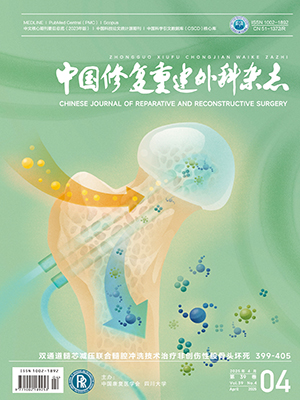| 1. |
Kim YI, Kang HG, Kim JH, et al. Closed intramedullary nailing with percutaneous cement augmentation for long bone metastases. Bone Joint J, 2016, 98-B(5): 703-709.
|
| 2. |
Miller BJ, Gao Y, Duchman KR. Does surgery or radiation provide the best overall survival in Ewing’s sarcoma? A review of the National Cancer Data Base. J Surg Oncol, 2017, 116(3): 384-390.
|
| 3. |
Demir B, Yavuz U, Akpinar E, et al. A novel biological reconstruction of tibial bone defects arising after resection of tumors. Acta Orthop Traumatol Turc, 2016, 50(2): 248-254.
|
| 4. |
Kim YI, Kang HG, Kim TS, et al. Palliative percutaneous stabilization of lower extremity for bone metastasis using flexible nails and bone cement. Surg Oncol, 2014, 23(4): 192-198.
|
| 5. |
Egeland MT, Tarangen M, Shiryaeva O, et al. Evaluation of strategies for increasing response rates to postal questionnaires in quality control of nasal septal surgery. BMC Res Notes, 2017, 10(1): 189.
|
| 6. |
Karnofsky DA, Burchenal JH. The clinical eraluation of chemotherapeutic agents in cancer//Macelod CM, eds. Evaluation of chemotherapeutic Agents. New York: Columbia University Press, 1994: 191-205.
|
| 7. |
Xu L, Li X, Wang Z, et al. Functional evaluation for patients with lower extremity sarcoma: application of the Chinese version of Musculoskeletal Tumor Society scoring system. Health Qual Life Outcomes, 2017, 15(1): 107.
|
| 8. |
Kamal AF, Widyawarman H, Husodo K, et al. Clinical Outcome and Survival of Osteosarcoma Patients in Cipto Mangunkusumo Hospital: Limb Salvage Surgery versus Amputation. Acta Med Indones, 2016, 48(3): 175-183.
|
| 9. |
Schaser KD, Melcher I, Mittlmeier T, et al. Surgical management of vertebral column metastatic disease. Unfallchirurg, 2007, 110(2): 137-161.
|
| 10. |
Stihsen C, Panotopoulos J, Puchner SE, et al. The outcome of the surgical treatment of pelvic chondrosarcomas: a competing risk analysis of 58 tumours from a single centre. Bone Joint J, 2017, 99-B(5): 686-696.
|
| 11. |
Augat P, Hoegel F, Stephan D, et al. Biomechanical effects of angular stable locking in intramedullary nails for the fixation of distal tibia fractures. Proc Inst Mech Eng H, 2016, 230(11): 1016-1023.
|
| 12. |
Deheshi BM, Jaffer SN, Griffin AM, et al. Joint salvage for pathologic fracture of giant cell tumor of the lower extremity. Clin Orthop Relat Res, 2007, 459: 96-104.
|
| 13. |
Liu XW, Jin P, Liu K, et al. Comparison of percutaneous long bone cementoplasty with or without embedding a cement-filled catheter for painful long bone metastases with impending fracture. Eur Radiol, 2017, 27(1): 120-127.
|
| 14. |
Yun HH, Lee YI, Kim KH, et al. Use of auxiliary locking plates for the treatment of unstable pertrochanteric femur fractures. Orthopedics, 2015, 38(5): 305-309.
|
| 15. |
Heyland M, Duda GN, Haas NP, et al. Semi-rigid screws provide an auxiliary option to plate working length to control interfragmentary movement in locking plate fixation at the distal femur. Injury, 2015, 46 Suppl 4: S24-32.
|
| 16. |
Archdeacon MT, Wyrick JD. Reduction plating for provisional fracture fixation. J Orthop Trauma, 2006, 20(3): 206-211.
|
| 17. |
Oh JK, Sahu D, Park JW, et al. Use of 2.0 mini plate system as reduction plate. Arch Orthop Trauma Surg, 2010, 130(10): 1239-1242.
|




